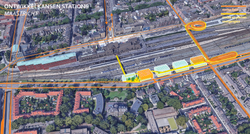
 |  |
|---|---|
 |  |
 |  |
 |  |
 |  |
 |  |
 |  |
Also see:
Download Link complete report Track-Landscapes
Download link (high resolution)
Client: Ministry of Water Management and Infrastructure and Tour de Force
Date trajectory: 2020-07 <-> 2020-10
Project status: This report is part of the Development Agenda for the Future of Public Transport 2040, sent to the House of Representatives in January 2021 by State Secretary Van Veldhoven.
Future tasks for Fiets+OV
In the 'chains and nodes' project, the Ministry of Infrastructure and Water Management is currently formulating its vision on the future of public transport in the Netherlands. The current mobility system mainly consists of separate networks for public transport, car and/or bicycle and walking. Further integration of these networks is desirable in the future in order to be able to cope with the increasing demand for mobility. The bicycle, as pre- and post-transport for public transport, must become an increasingly important one towards 2040 become a form of mobility.
In the first inventories, the most frequently mentioned task appeared to be the expansion of parking facilities for people who use the bicycle as pre- and/or after-transport for the train. But it turned out that there were also various other types of bicycle + public transport assignments.
In order to gain a better insight into the national bicycle + public transport tasks, TRACK made a further analysis of various categories of public transport nodes. Ten tasks for bicycle + public transport were formulated from the analyses, and further elaborated by means of literature studies and design.
For example, it appears that there is still much to be gained in the way in which bicycle sheds are placed in the station surroundings. Often these do not logically and fluently match the direction (origin/destination) of the cyclists. Design research provided examples of ways in which the future expansion of bicycle sheds can be logically integrated into the spatial development of the station. In line with the natural direction of the cyclist.
In addition, opportunities were worked out in various themes: the potential of shared bicycles and the influence of the emergence of the e-bike on public transport, especially in rural areas, the choices made by cyclists for suburban stations or intercity stations, and the quality of bicycle routes to stations.


